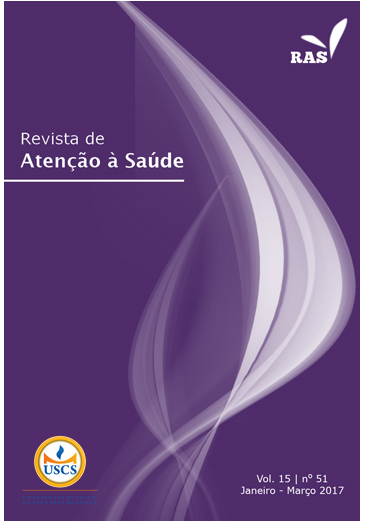Factors connected to axillary colonization by resistant organisms of intensive care unit patients
DOI:
https://doi.org/10.13037/ras.vol15n51.3941Keywords:
Control Infections, Microbial Drug Resistance, Patient Safety, Intensive Care Unit, Antimicrobial SusceptibilityAbstract
Introduction: The spread of bacterial resistance is almost always linked to colonized or infected patients. The detection of patients colonized allows timely implementation of interventions to prevent transmission of resistant organisms and consequently infection. Objective: To analyze incidence colonization by resistant microorganism (MR) in the axillary region and possible risk factors in patients admitted to an Intensive Care Unit (ICU). Materials and methods: It is about a historical cohort study conducted between august 2013 and august 2015, involving 837 patients. The data were collected from the medical records of patients and results of microbiological tests. Results and conclusions: Among the patients studied, 122 (14.6%) were colonized by MR, especially: Enterobacter sp. 25%, Acinetobacter baumannii 20%, Staphylococcus aureus 15%, Pseudomonas aeruginosa 12%. The factors associated with colonization by resistant microorganisms were: length of stay in ICU ? 9 (OR = 32.4), use of invasive procedure (OR = 25.7) and the use of antimicrobial (OR = 13.9). The relationship between colonization by MR and risk factors shows the need for monitoring and protocol institution aimed at accession to the control measures of the spread of these microorganisms.
Downloads
References
- Minhas P, Perl TM, Carroll KC, Shepard JW, Shangraw KA, Fellerman D, et al. Risk factors for positive admission surveillance cultures for methicillin-resistant Staphylococcus aureus and vancomycin-resistant enterococci in a neurocritical care unit. Crit Care Med 2011; 39(10): 2322-9.
- European Centre for Disease Prevention And Control. Health care associated infections. Disponível em: http//:www.ecdc.europa.eu/en/healthtopics/Healthcare-associated infections/Pages/index.aspx. (Acessado em 15 de setembro de 2015).
- Nascimento PVFS, Silva LGDM, Madureira PR. Fatores preditores para infecção ou colonização por bactérias multidroga resistentes: um estudo de caso-controle. J Infect Control 2013; 2(2):117-123.
- Lee CC, Lee CH, Hong MY. Risk factors and outcome of Pseudomonas aeruginosa bacteremia among adults visiting the ED. Am J Emerg Med 2012; 30(6): 852-60.
- Chen YE, Tsao H. (2013) The Skin Microbiome: Current Perspectives and Future Challenges. Journal of the American Academy of Dermatology 2013; 69: 143-155.
- Thurlow CJ, Prabaker K, Lin MY, Lolans K, Weinstein RA, Hayden MK. Anatomic sites of patient colonization and environmental contamination with Klebsiella pneumoniae carbapenemase-producing Enterobacteriaceae at long-term acute care hospitals. Infect Control Hosp. Epidemiol 2013; 34(1): 56–61.
- Birgand G, Lefevre LA, Lolom I, Ruppe E, Andremont A, Lucet JC. Duration of colonization by extended-spectrum b-lactamase-producing Enterobacteriaceae after hospital discharge. Am J Infect Control 2013; 41 (5): 443-7.
- Marshall C, Richards M, Mcbryde E. Do Active Surveillance and Contact Precautions Reduce MRSA Acquisition? A Prospective Interrupted Time Series. PLOS ONE 2013; 8(3): 1-9.
- Vikram HR, Dumiga DG, Kohan C, Havill NL, Tauman A, Boyce JM. Discontinuation of contact precautions for patients no longer colonized with methicillinresistant Staphylococcus aureus. Infect. Control. Hosp Epidemiol 2010; 31(5): 541-3.
- Martinez-Capolino C, Reyes K, Johnson L, Sullivan J, Samuel L, Digiovine B, et al. Impact of active surveillance on methicillin resistant Staphylococcus aureus transmission and hospital resource utilization. J Hosp Infect 2010; 74: 232- 7.
- Khanal R, Sah P, Lamichhane P, Lamsal A, Upadhaya S, Pahwa VK. Nasal carriage of methicillin resistant Staphylococcus aureus among health care workers at a tertiary care hospital in Western Nepal. Antimicrobial Resistance and Infection Control 2015; 39(4): 1-5.
- Mermel LA, Cartony JM, Covington P, Maxey G, Morse D. Methicillin-Resistant Staphylococcus aureus colonization at different body sites: A prospective, quantitative analysis. J Clin Microbiol 2011; 49(3): 1119-1121.
- Clinical and Laboratory Standards Institute (CLSI). Performance standards for antimicrobial disk susceptibility tests; approved standard—tenth edition (CLSI document M02-A10). Wayne, PA: Clinical and Laboratory Standards Institute, 2011.
- Sievert DM, Ricks P, Edwards JR, Schneider A, Patel J, Srinivasan A, et al. Antimicrobial-resistant pathogens associated with healthcare-associated infections: summary of data reported to the national healthcare safety network at the centers for disease control and prevention, 2009-2010. Infection Control Hospital Epidemiology 2013; 34: 1213-1214.
- Moraes GM, Cohrs FM, Batista REA, Grinbaum RS. Infecção ou colonização por micro-organismos resistentes: identificação de preditores. Acta paulista de Enfermagem 2013; 26(2): 185-191.
- Abreu PM, Farias PG, Paiva GS, Almeida AM, Morais PV. Persistence of microbial communities including Pseudomonas aeruginosa in a hospital environment: a potential health hazard. BMC Microbiol 2014; 28: 114:18.
- Ribas RM, Contijo Filho PG, Cezário RC, Silva PF, Langoni DR, Duque AS. Fatores de risco para a colonização por bactérias hospitalares multirresistentes em pacientes críticos, cirúrgicos e clínicos em um hospital universitário brasileiro. Rev Med Minas Gerais 2009; 19(3): 193-7.
- Oliveira AC, Silva RS, Piscoya Díaz ME, Iquiapaza RA. Resistência bacteriana e mortalidade em um centro de tera¬pia intensiva adulto de um Hospital Universitário. Rev Latino-Am Enfermagem 2010; 18 (6): 1152-1160.
- Oliveira AC, Damasceno QS, Piscoya M, Nicoli JR. Epidemiologic characteristics of resistant microorganisms present in reserves from an intensive care unit. American Journal Infection Control 2012; 40(2): 1-3.
- Ribas RM, Contijo Filho PG, Cezário RC, Silva PF, Langoni DR, Duque AS. Fatores de risco para a colonização por bactérias hospitalares multirresistentes em pacientes críticos, cirúrgicos e clínicos em um hospital universitário brasileiro. Rev Med Minas Gerais 2009; 19(3): 193-197.
- Grice EA, Kong HH, Conlan S, Deming CB, Davis J, Young AC. Topographical and temporal diversity of the human skin microbiome. Science 2009; 324: 1190-1192.
- Damaceno Q, Nicolli JR, Oliveira A. Variability of cutaneous and nasal population levels between patients colonized and infected by multidrug-resistant bacteria in two Brazilian intensive care units. SAGE Open Medicine 2015; 3: 1-7.
- Fortaleza CMB, Freitas FM, Lauterbach GP. Colonization pressure and risk factors for acquisition of imipenem-resistant Acinetobacter baumannii in a medical surgical intensive care unit in Brazil. American Journal Infection Control 2013; 41: 263-265.
- Almeida GCM, Lima NGM, Santos MM, Melo MCN, Lima KC. Colonização nasal por Staphylococcus sp. em pacientes internados. Acta Paul Enferm 2014; 27(3): 273-279.
- Kim YJ, Kim S, Kim YR, Lee JY, Park YJ, Kang MW. Risk factors for vancomycin-resistant enterococci infection and mortality in colonized patients on intensive care unit admission. Am J Infect Control 2012; 40: 1018–1019.
- Babady NE, Gilhuley K, Cianciminio-Bordelon D, Tang YW. Performance characteristics of the Cepheid Xpert vanA Assay for rapid identification of patients at high risk for carriage of vancomycin-resistant Enterococci. J Clin Microbiol 2012; 50: 3659–3663.
- Mendes W, Pavão ALB, Martins M, Moura ALO, Travassos C. Características de eventos adversos evitáveis em hospitais do Rio de Janeiro. Revista da Associação Médica Brasileira 2013; 59(5): 421-428.
Downloads
Published
Issue
Section
License
Policy Proposal for Journals offering Free Delayed Access
Authors who publish in this magazine agree to the following terms:
- Authors maintain the copyright and grant the journal the right to the first publication, with the work simultaneously licensed under a Creative Commons Attribution License after publication, allowing the sharing of the work with recognition of the authorship of the work and initial publication in this journal.
- Authors are authorized to assume additional contracts separately, for non-exclusive distribution of the version of the work published in this magazine (eg, publishing in institutional repository or as a book chapter), with the acknowledgment of the authorship and initial publication in this journal.
- Authors are allowed and encouraged to publish and distribute their work online (eg in institutional repositories or on their personal page) at any point before or during the editorial process, as this can generate productive changes, as well as increase impact and citation of the published work (See The Effect of Open Access).









